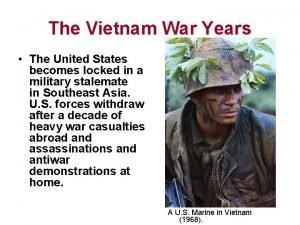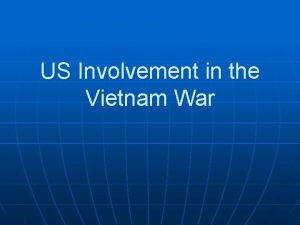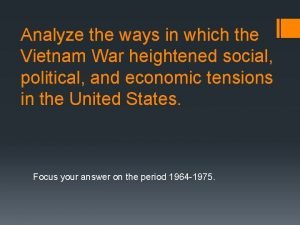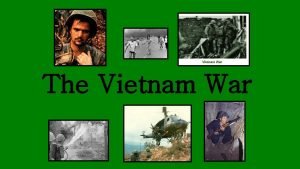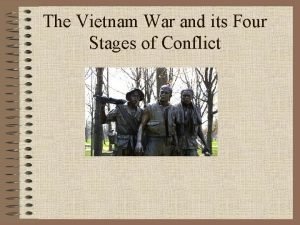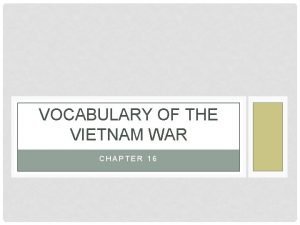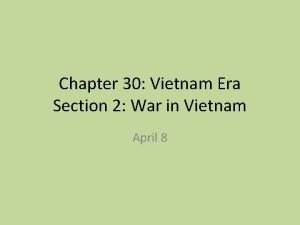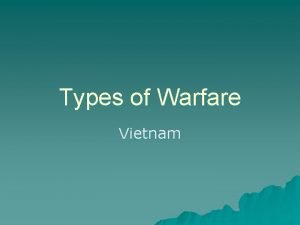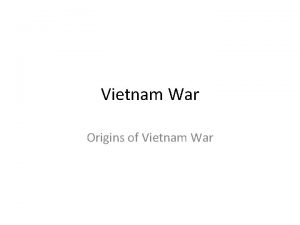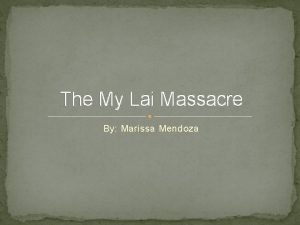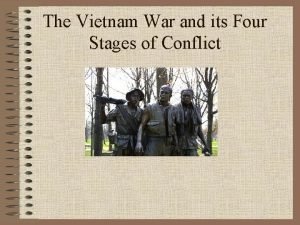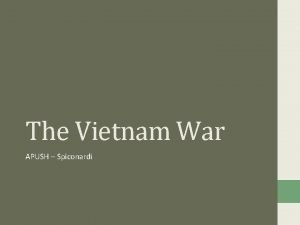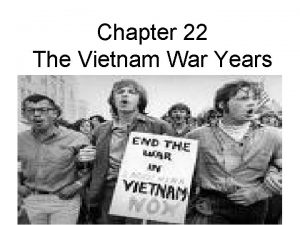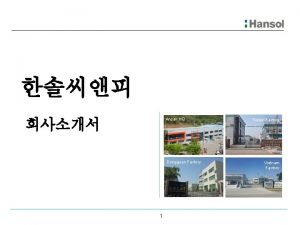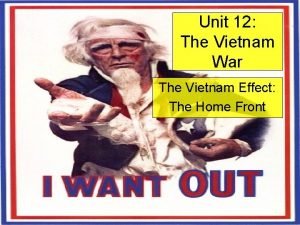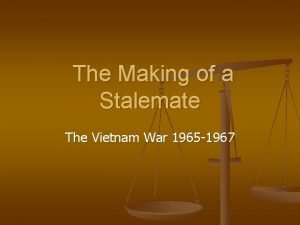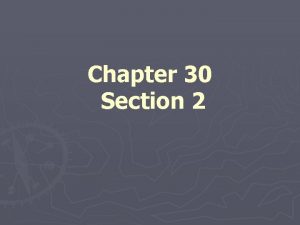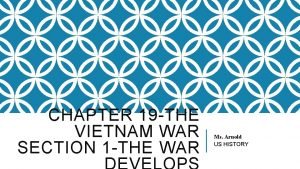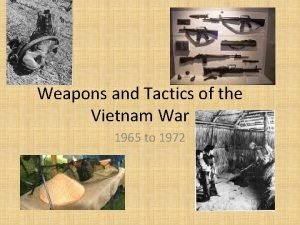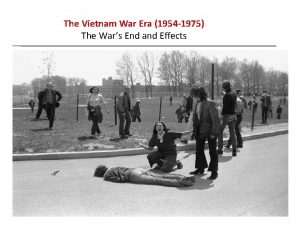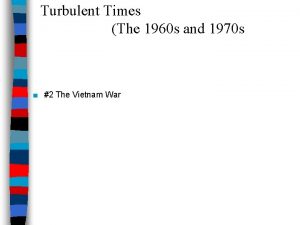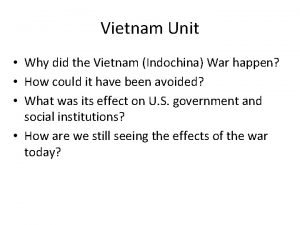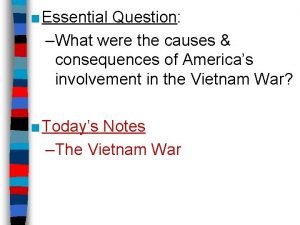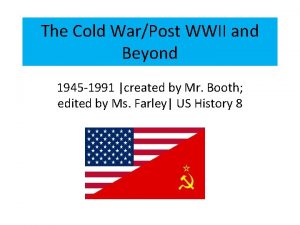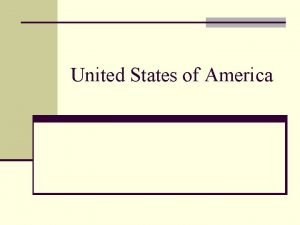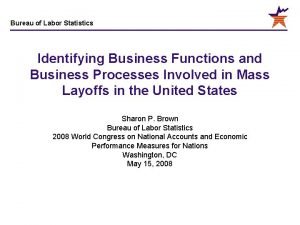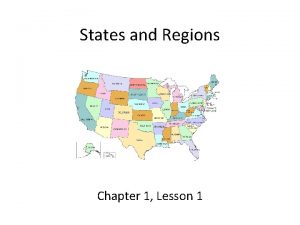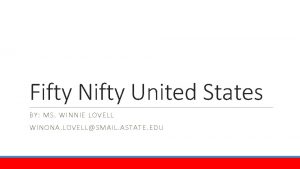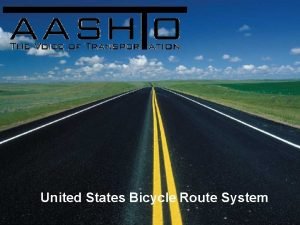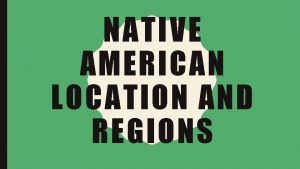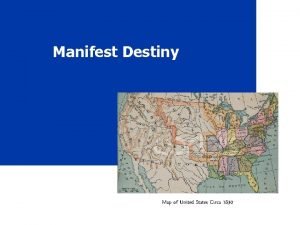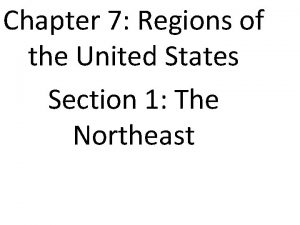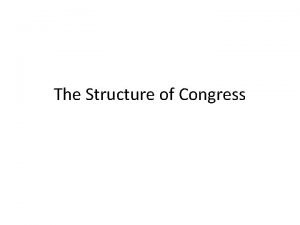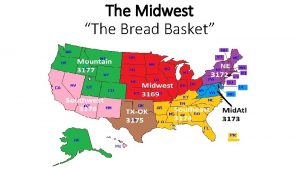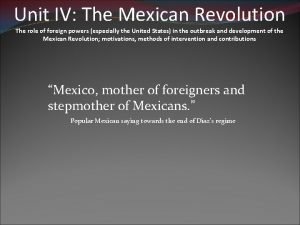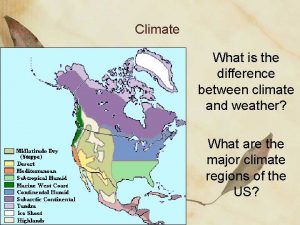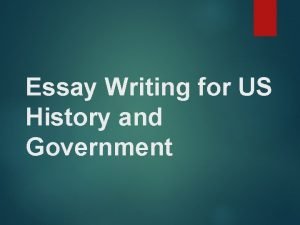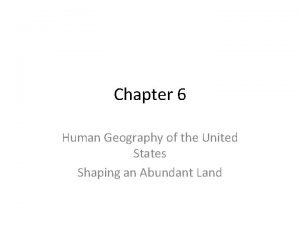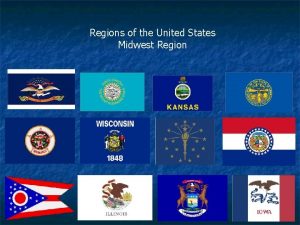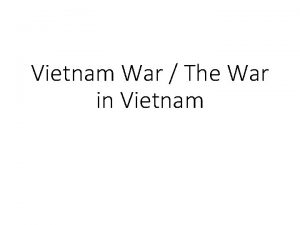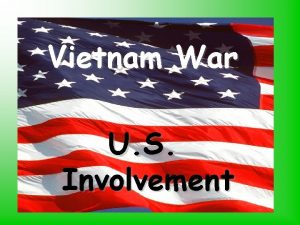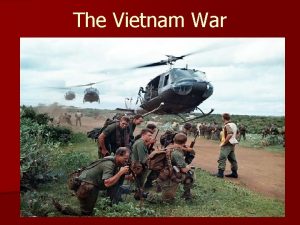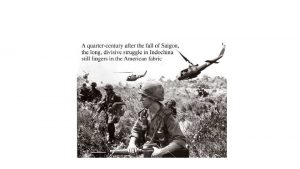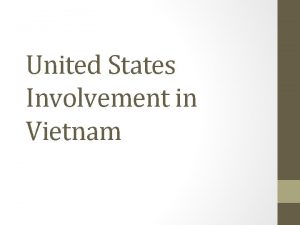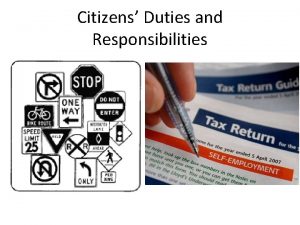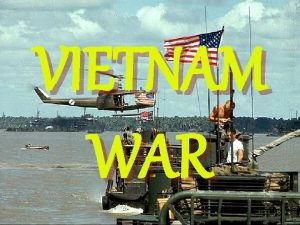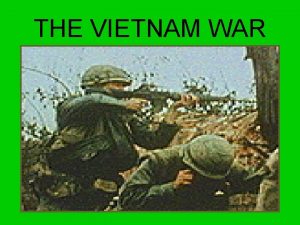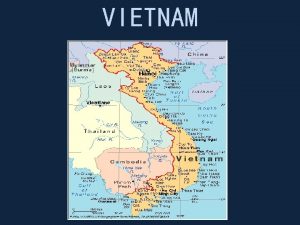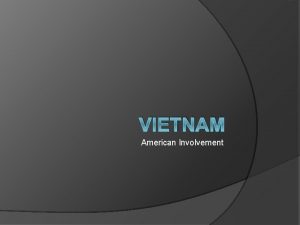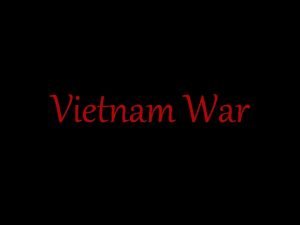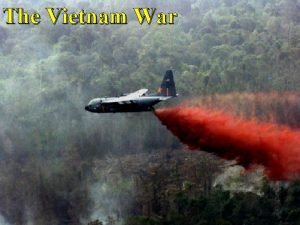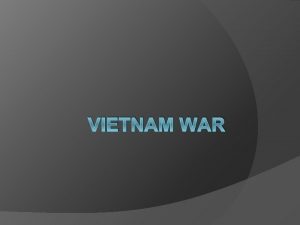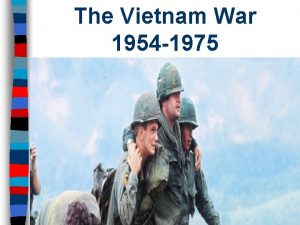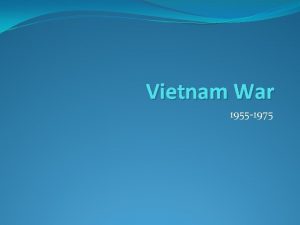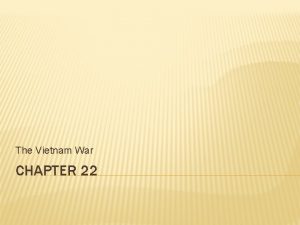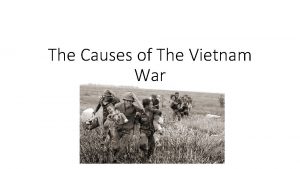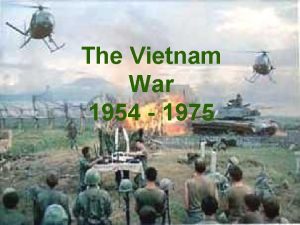Vietnam War United States Involvement In Vietnam citizens














































- Slides: 46

Vietnam War & United States Involvement

In Vietnam, citizens refer to this conflict as the American War In the United States we refer to this conflict as the Vietnam War

• The Vietnam War was the longest and most unpopular war in American history. • During the war: – 58, 000 Americans lost their lives. • The oldest man killed was 62 years old; the youngest, 16. • 61% of the men killed were 21 or younger. – 304, 000 were wounded. – 75, 000 were severely disabled. – The United States spent over $200 billion dollars on the war.

A WAR OF COLONIAL INDEPENDENCE AGAINST THE FRENCH • Vietnam had been a French colony under the name of French Indochina (along with Cambodia and Laos) • Vietnam began to fight for its independence from France during WW II (when France was preoccupied with European conflict). During WWII the U. S. aided France in it’s efforts to keep control of Vietnam. • the Vietnamese revolutionary leader was Ho Chi Minh, a Communist

The South Establishes Itself • the decision of the conference was to partition Vietnam into a communist North led by Ho and a “democratic” South Vietnam led by Ngo Dinh Diem • this colonial war raged from 1946 -54, culminating in the French defeat at Dienbienphu • Geneva Peace Accords: Provided for the temporary partition of Vietnam at the 17 th parallel, and called for the two Vietnams to hold national elections within two years. • The following year, with American assistance, Ngo Dinh Diem became president of South Vietnam. (Because he wasn’t communist)

The National Liberation Front • Vietcong: Communist Vietnamese in SOUTH Vietnam • Vietminh: Communist Vietnamese in NORTH Vietnam [it’s a geographical distinction]

North vs. South Vietnam • NFL (National Liberation Front) • CAPITOL: HANOI • The North was supported by Communist China and Soviet Union. • Ho Chi Minh had hoped his ideals and freedom from foreign rule would bring US support, but his Communist politics pushed US support to the South. • The South was supported by the United States. • CAPITOL: SAIGON • The United States saw the emergence of Communism under Ho Chi Minh in the North as a threat. (CONTAINMENT & DOMINO THEORY) GOAL OF THE UNITED STATES IN VIETNAM: CONTAIN THE SPREAD OF COMMUNISM

DRAFT • The Draft had never gone away after WWII • During the Kennedy Administration there were two main ways men avoided going to Vietnam. 1. names of married men with children should occupy the very bottom of the draft list 2. There were exemptions and deferments, especially for college and graduate students. This was the source of considerable resentment among poor and working class young men, who could not afford a college education.

DRAFT UNDER NIXON • Under Nixon the draft system was reformed by the department of Defense in order to eliminate inequalities. • The ability to acquire college deferments was taken away. • A Lottery System was put into place 26 th Amendment: standardized the voting age to 18, of you are old enough to serve in the military and die for your country you deserve the right to vote. MLK Thought it was unfair that African American troops in Vietnam were fighting for a country that treated them like 2 nd class citizens.

• Diem's brother, Ngo Dinh Nhu, had raided the Buddhist pagodas of South Vietnam, claiming that they had harbored the Communists that were creating the political instability. • The result was massive protests on the streets of Saigon that led Buddhist monks to selfimmolation. • The pictures of the monks engulfed in flames made world headlines and caused considerable consternation in Washington.

Assignations in Vietnam and Home • In 1963, some of Diem's own generals approached the American Embassy in Saigon with plans to overthrow Diem. • With Washington's tacit approval, Diem and his brother were captured and later killed. • Three weeks later, President Kennedy was assassinated on the streets of Dallas.

LBJ & Vietnam • The Kennedy administration had managed to run the war from Washington without the large-scale introduction of American combat troops. Americans who supported the war and the Johnson administration became known as hawks • the new president, Lyndon Baines Johnson, that more aggressive action was needed. • Johnson administration argued for expansive war powers for the president.

Mc. Namara’s Secret Trip Johnson’s Decision • LBJ sends Secretary of State Robert Mc. Namara to Saigon on a secret trip 1. 2. 3. Claimed that the communists would win within 2 -3 months Urged immediate deployment of Large #’s of Troops. Wanted to bomb North Vietnam ASAP • Johnson thought this was too drastic so he held off sending more “advisors” and secretly planned to send troops to Southeast Asia soon.

GULF OF TONKIN • 8 -1 -64 The Destroyer MADDOX was monitoring shelling in the Gulf of Tonkin. N. Vietnamese fired two torpedoes at it and missed, and the MADDOX Sank one and crippled others. • RESPONSE: Return to the Gulf of Tonkin with another destroyer C. Turner Joy. • 8 -4 -64 Both ships said they were under attack (sonar and radar contacts and questionable visual sightings of torpedoes. )

The Gulf of Tonkin Resolution • the US had come to see South Vietnam as a “domino” that they couldn’t afford to lose • The U. S. never formally issued a declaration of war Because ONLY CONGRESS can declare war!!!!! • Congress passed the Gulf of Tonkin Resolutions (August 1964) - By doing this Congress gave Johnson the power to declare war in Vietnam through the commitment of American personnel and materiel. They allowed the president to use military force in Vietnam.

STRATEGIES: By the U. S. military during the Vietnam War • GREEN BERETES Guerilla Fighting Tactics • Body Counts: to show that the US was winning the war. • Search and Destroy Missions • Napalm & Agent Orange

Operation Rolling Thunder • In early 1965, the NLF attacked two U. S. army installations in South Vietnam, and as a result, Johnson ordered sustained bombing missions over North Vietnam. • The bombing missions, known as “Operation Rolling Thunder, ” caused the Communist Party to reassess its own war strategy

Phosphorous & Napalm Bombs • “Operation Rolling Thunder” was backed up by phosphorous and napalm bombs – the latter causing dreadful burns to thousand of innocent civilians.


Helicopters • Of all aircraft, the helicopter was the most useful, dropping platoons in the jungle clearings and getting out again. They were excellent air ambulances.

North Vietnamese Tactics • The North Vietnamese used guerrilla tactics. – “Guerrillas must move through the peasants like fish through sea, ” i. e. , the peasants will support them as much as they can with shelter, food, weapons, storage, intelligence, recruits.

North Vietnamese Weapons – The AK 47 assault rifle out-performed the American M 16 – The portable rocket launcher took out many US vehicles & aircraft. – They recycled dud bombs dropped by the Americans. Deadly booby-traps could inflict huge damage on young Americans – The Vietnamese built large tunnel complexes such as the ones at Cu Chi near Saigon. This protected them from the bombing raids by the Americans and gave them cover for attacking the invaders.

• in spite of ongoing escalation throughout the 1960 s, the US experienced a lack of success against the Vietnamese guerrilla forces in S. Vietnam (the Vietcong) as the US Army was unprepared for their tactics and mentality. § The US was also never entirely successful in shutting down the Ho Chi Minh Trail, a supply line that ran between North and South Vietnam through difficult jungle terrain, mostly through Laos and Cambodia that enabled the North Vietnamese to send supplies to the Vietcong

The Tet Offensive • By 1968, things had gone from bad to worse for the Johnson administration. In late January, North Vietnam and the NLF launched coordinated surprise attacks against major southern cities. • These attacks, known as the Tet Offensive, were designed to force the Johnson administration to the bargaining table.

Tet Offensive • The Tet offensive caused most Americans to turn against the war. • In large part because Vietnam was a TV War where American audiences saw the brutality of war firsthand. It became known as the “Living Room War” Before the Tet offensive Americans believed that the enemy was weak and the war would end soon

The My Lai Massacre • A serious blow to U. S. credibility came with the exposure of the My Lai massacre (March 1968). • Hushed up at the time and discovered by a journalist, this involved the killing of 400 men, women and children by US troops.

C O U N T E R C U L T U R E

Counter Culture & Anti-War Sentiments • As the Counterculture gathered momentum (Hippies, Flower Children, etc. ), protests became widespread and began to polarize the nation


Anti-War Protests • Protests erupted on college campuses and in major cities at first, but by 1968 every corner of the country seemed to have felt the war's impact.


American Youth Say Peace • this was intensified after the Kent State Massacre – National Guardsmen opened fire on student protestors in Ohio, killing four, and by Senator William Fulbright’s (Chairman of the Senate Armed Forces the American people came to perceive Committee) admission that the • increasingly the “Credibility Gap”, i. e. they no longer believed war was a “mess” that LBJ was telling them the truth about events in the war • in 1968, LBJ chose not to run for president, and Republican Richard M. Nixon was elected on a platform of “Peace with Honour”

1968 Democratic Convention Candidates Republican Democratic American Independent Richard Nixon Hubert Humphrey George Wallace • One of the most famous incidents in the anti-war movement was the police riot in Chicago during the 1968 at the Democratic National Convention. • Hundreds of thousands of people came to Chicago in August 1968 to protest American intervention in Vietnam and the leaders of the Democratic Party who continued to prosecute the war.

Nixon & Vietnam • Nixon wanted a gradual handover of the ground war to the South Vietnamese, a policy he labeled Vietnamization (peace with honor) • in spite of that, Nixon escalates the war in Vietnam when he orders an secret invasion of Cambodia • He relied on the diplomacy of Henry Kissinger to achieve peace and/or an American withdrawal • the US by Jan. 27, 1973 Nixon explaining the Cambodian invasion to Americans on TV.

CAMBODIA • RESPONSE: – Congress repealed the Gulf of Tonkin resolution – Congress pass a law banning the use of ground forces in Cambodia – College Campuses erupted in protest. • Nixon agreed to the bombing of Cambodia in spite of his “Vietnamization”.

Pentagon Papers: June 1971 • The Pentagon Papers: The product of Robert Mc. Namara’s trip to Saigon under President Johnson’s administration concerning the deception that had led the U. S. into the Vietnam War. – The papers were published in the New York Times. • Nixon tried to have the publishing of the papers stopped on the grounds of National Security, but the Supreme Court allowed it.

Paris Peace Treaty & Cease Fire • The 1973 cease-fire that Nixon negotiated contained the following: – An election to determine the fate of the nation that would be held at some point in the future – South Vietnam could continue to receive limited U. S. support but no troops. • Paris Peace Treaty that Henry Kissinger negotiated: 1. 2. 3. U. S. forces would be withdrawn from South Vietnam in 60 days An immediate cease fire. And all American POWs in north Vietnam would be releases

The U. S Pulls Out • the NVA easily defeats the South by 1975; the South had appealed to Nixon for aid, which had been promised, but by 1975 Nixon was embroiled in the domestic Watergate Crisis, and he was in essence a “lame duck” • 1975 – the US abandoned its embassy in Saigon, which was renamed Ho Chi Minh City in the newly unified and communist Vietnam

In the End • The United States lost respect in the eyes of foreigners the world over • The United States lost the confidence of it’s military powers. • The United States lost the credibility of it’s government.

WAR POWERS ACT • Required that the president report to Congress any commitment of American Troops or if the United States is already under attack or serious threat. The War Powers Resolution requires the president to notify Congress within 48 hours of committing armed forces to military action • The main purpose of the act was to restrict the power of the United States President thereby hopefully preventing another Vietnam from ever happening.

Costs of War • Of the 2. 7 million • On the Vietnamese side it Americans that served in is estimated… the Vietnam war… • 1. 1 million North • 300, 000 were wounded in Vietnamese and Viet Cong action (Southern resistance soldiers) were killed • 75, 000 were disabled • Of the casualties listed on • Over 2 million North and South Vietnamese citizens The Wall, approximately were killed 1, 300 remain missing in action • 58, 129 were killed • The average was 19

Vietnam Now • Population: 85 million, the 13 th largest country in the world • Capital: Hanoi • Largest city: Ho Chi Minh City • Government system: Socialist Republic • Resources: Mostly rice (in both Northern and Southern Deltas)

Hanoi Hue Ho Chi Minh City



 United states vietnam
United states vietnam Description
Description Presidential and radical reconstruction venn diagram
Presidential and radical reconstruction venn diagram Vietnam
Vietnam Analyze the ways in which the vietnam war heightened social
Analyze the ways in which the vietnam war heightened social Results of vietnam war
Results of vietnam war Stages of the vietnam war
Stages of the vietnam war Vietnam war vocabulary
Vietnam war vocabulary Causes of the vietnam war
Causes of the vietnam war Vietnam war traps
Vietnam war traps Vientcong
Vientcong Vietnam war massacre
Vietnam war massacre Stages of the vietnam war
Stages of the vietnam war Vietnam war apush
Vietnam war apush The domino theory vietnam war
The domino theory vietnam war Reason for vietnam war
Reason for vietnam war Vietnam war
Vietnam war Pro vietnam war slogans
Pro vietnam war slogans Did the vietnam war end in a stalemate
Did the vietnam war end in a stalemate Agent orange and napalm
Agent orange and napalm President nixon endorsed vietnamization because
President nixon endorsed vietnamization because Us weapons vietnam war
Us weapons vietnam war Effects of the vietnam war
Effects of the vietnam war Vietnam war 1960
Vietnam war 1960 Operation rolling thunder cold war
Operation rolling thunder cold war What were the causes and effects of the vietnam war
What were the causes and effects of the vietnam war Vietnam war at home webquest answers
Vietnam war at home webquest answers Geographical position usa
Geographical position usa United states bureau of labor statistics
United states bureau of labor statistics Ibn-tamas v. united states
Ibn-tamas v. united states 5 regions of united states
5 regions of united states North south east west in our calm objective opinion
North south east west in our calm objective opinion United states bicycle route system
United states bicycle route system Ap grading review
Ap grading review Awake united states song
Awake united states song Native american tribes in the united states
Native american tribes in the united states Manifest destiny map
Manifest destiny map The united states ought to provide a universal basic income
The united states ought to provide a universal basic income What are the 7 regions of the united states?
What are the 7 regions of the united states? 2 houses of congress
2 houses of congress Bread basket jefferson
Bread basket jefferson What the united states has fought for
What the united states has fought for Subtropical united states
Subtropical united states United states history and government regents
United states history and government regents United states and canada physical map
United states and canada physical map Why is the united states called a postindustrial economy
Why is the united states called a postindustrial economy Midwest region of the united states
Midwest region of the united states
